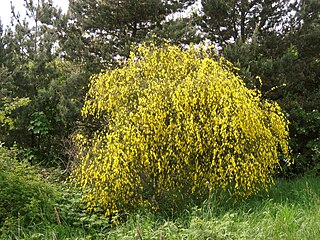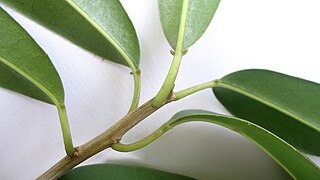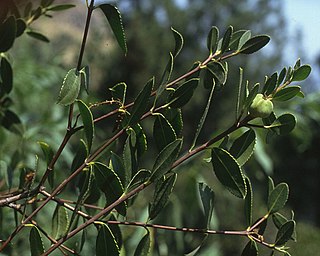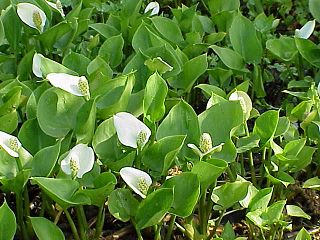| Shirakiopsis | |
|---|---|
| Scientific classification | |
| Kingdom: | Plantae |
| Clade: | Angiosperms |
| Clade: | Eudicots |
| Clade: | Rosids |
| Order: | Malpighiales |
| Family: | Euphorbiaceae |
| Subfamily: | Euphorbioideae |
| Tribe: | Hippomaneae |
| Subtribe: | Hippomaninae |
| Genus: | Shirakiopsis Esser, 1999 |
Shirakiopsis is a genus of flowering plants in the family Euphorbiaceae first described as a genus in 1999. [1] [2] There are six known species, 3 native to tropical Asia and 3 to tropical Africa. [3] [4] [5]
A genus is a taxonomic rank used in the biological classification of living and fossil organisms, as well as viruses, in biology. In the hierarchy of biological classification, genus comes above species and below family. In binomial nomenclature, the genus name forms the first part of the binomial species name for each species within the genus.

The Euphorbiaceae, the spurge family, is a large family of flowering plants. In common English, they are sometimes called euphorbias, which is also the name of a genus in the family. Most spurges such as Euphorbia paralias are herbs, but some, especially in the tropics, are shrubs or trees, such as Hevea brasiliensis. Some, such as Euphorbia canariensis, are succulent and resemble cacti because of convergent evolution. This family occurs mainly in the tropics, with the majority of the species in the Indo-Malayan region and tropical America a strong second. A large variety occurs in tropical Africa, but they are not as abundant or varied as in the two other tropical regions. However, Euphorbiaceae also has many species in nontropical areas such as the Mediterranean Basin, the Middle East, South Africa, and the southern United States.

Asia is Earth's largest and most populous continent, located primarily in the Eastern and Northern Hemispheres. It shares the continental landmass of Eurasia with the continent of Europe and the continental landmass of Afro-Eurasia with both Europe and Africa. Asia covers an area of 44,579,000 square kilometres (17,212,000 sq mi), about 30% of Earth's total land area and 8.7% of the Earth's total surface area. The continent, which has long been home to the majority of the human population, was the site of many of the first civilizations. Asia is notable for not only its overall large size and population, but also dense and large settlements, as well as vast barely populated regions. Its 4.5 billion people constitute roughly 60% of the world's population.
These are trees and shrubs producing a milky latex. [3] Their smaller branches are coated in pale-colored, yellowish, or sometimes reddish hairs. The toothed oblong to oval leaves are alternately arranged and there are small ovate to triangular stipules. The inflorescences are thyrses at the branch tips. The plants are monoecious; the inflorescence holds a few male flowers with usually one to three female flowers at the base. The male flower has three stamens. The female flower has 2 or 3 stigmas. There are no petals. The fruit is smooth, dry, and woody or occasionally slightly fleshy, and contains 2 or 3 seeds in each of its chambers. [4]

In botany, a tree is a perennial plant with an elongated stem, or trunk, supporting branches and leaves in most species. In some usages, the definition of a tree may be narrower, including only woody plants with secondary growth, plants that are usable as lumber or plants above a specified height. In wider definitions, the taller palms, tree ferns, bananas, and bamboos are also trees. Trees are not a taxonomic group but include a variety of plant species that have independently evolved a trunk and branches as a way to tower above other plants to compete for sunlight. Trees tend to be long-lived, some reaching several thousand years old. Trees have been in existence for 370 million years. It is estimated that there are just over 3 trillion mature trees in the world.

A shrub or bush is a small- to medium-sized perennial woody plant. Unlike herbaceous plants, shrubs have persistent woody stems above the ground. They are distinguished from trees by their multiple stems and shorter height, less than 6 m-10 m (20 ft–33 ft) tall. Small shrubs, less than 2 m (6.6 ft) tall are sometimes termed subshrubs.

Latex is a stable dispersion (emulsion) of polymer microparticles in an aqueous medium. It is found in nature, but synthetic latexes can be made by polymerizing a monomer such as styrene that has been emulsified with surfactants.
- Species [5]
- Shirakiopsis aubrevillei (Leandri) Esser in R.H.A.Govaerts, D.G.Frodin & A.Radcliffe-Smith - Ivory Coast, Ghana
- Shirakiopsis elliptica (Hochst.) Esser in R.H.A.Govaerts, D.G.Frodin & A.Radcliffe-Smith - tropical + southern Africa from South Africa to Senegal and Ethiopia
- Shirakiopsis indica (Willd.) Esser - India, Bangladesh, Sri Lanka, Andaman & Nicobar, Indochina, Malaysia, Indonesia, Philippines, Papuasia, Caroline Islands
- Shirakiopsis sanchezii (Merr.) Esser - Mindanao, Sumbawa
- Shirakiopsis trilocularis (Pax & K.Hoffm.) Esser - Tanzania
- Shirakiopsis virgata (Zoll. & Moritzi ex Miq.) Esser - Java






